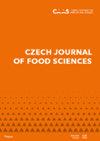Detection of soy in food from the Czech market using ELISA and PCR methods
IF 1
4区 农林科学
Q4 FOOD SCIENCE & TECHNOLOGY
引用次数: 0
Abstract
Soy is considered an allergen under Regulation No. 1169/2011 of the European Parliament and of the Council, which mandates the labelling of soy allergen on food packaging. This study is focused on detecting soy in food products using two kinds of methods. The first method, enzyme-linked immunosorbent assay (ELISA), was performed using two commercial kits (Veratox for Soy Allergen; Neogen, USA). The second method, polymerase chain reaction (PCR), was carried out with two different deoxyribonucleic acid (DNA)-isolating kits and DNA isolation via the cetyltrimethylammonium bromide (CTAB) method. A total of 57 samples of food were tested, including 45 samples of animal origin and 12 samples of plant origin. The results were compared with information on the packaging. From the group of samples that contained soy according to the packaging (12 pieces), 9 samples were found to be positive by ELISA method, 10 samples by the CTAB method and 11 samples by GeneSpin. On the other hand, from the group of samples that should not contain soy according to the packaging (30 pieces), the presence of soy in 2 samples was detected by ELISA. No significant difference was found between the examined methods. Results show that the situation on the market is satisfactory and that only products declared as containing traces of soy appear to be problematic.用ELISA和PCR方法检测捷克市场食品中的大豆
根据欧洲议会和理事会第1169/2011号条例,大豆被视为过敏原,该条例要求在食品包装上贴上大豆过敏原标签。本研究主要采用两种方法检测食品中的大豆。第一种方法,酶联免疫吸附测定(ELISA),使用两种商业试剂盒(Veratox for Soy Allergen;Neogen,USA)进行。第二种方法,聚合酶链式反应(PCR),用两种不同的脱氧核糖核酸(DNA)分离试剂盒进行,并通过十六烷基三甲基溴化铵(CTAB)方法进行DNA分离。共检测了57个食品样本,包括45个动物来源的样本和12个植物来源的样本。将结果与包装上的信息进行了比较。从根据包装的含有大豆的样品组(12个)中,通过ELISA法发现9个样品呈阳性,通过CTAB法发现10个样品,通过GeneSpin发现11个样品。另一方面,从根据包装不应含有大豆的样品组(30个)中,通过ELISA检测2个样品中是否存在大豆。两种检查方法之间没有发现显著差异。结果表明,市场上的情况令人满意,只有被宣布含有微量大豆的产品才有问题。
本文章由计算机程序翻译,如有差异,请以英文原文为准。
求助全文
约1分钟内获得全文
求助全文
来源期刊

Czech Journal of Food Sciences
Food Science & Technology, Chemistry-食品科技
CiteScore
2.60
自引率
0.00%
发文量
48
审稿时长
7 months
期刊介绍:
Original research, critical review articles, and short communications dealing with food technology and processing (including food biochemistry, mikrobiology, analyse, engineering, nutrition and economy). Papers are published in English.
 求助内容:
求助内容: 应助结果提醒方式:
应助结果提醒方式:


